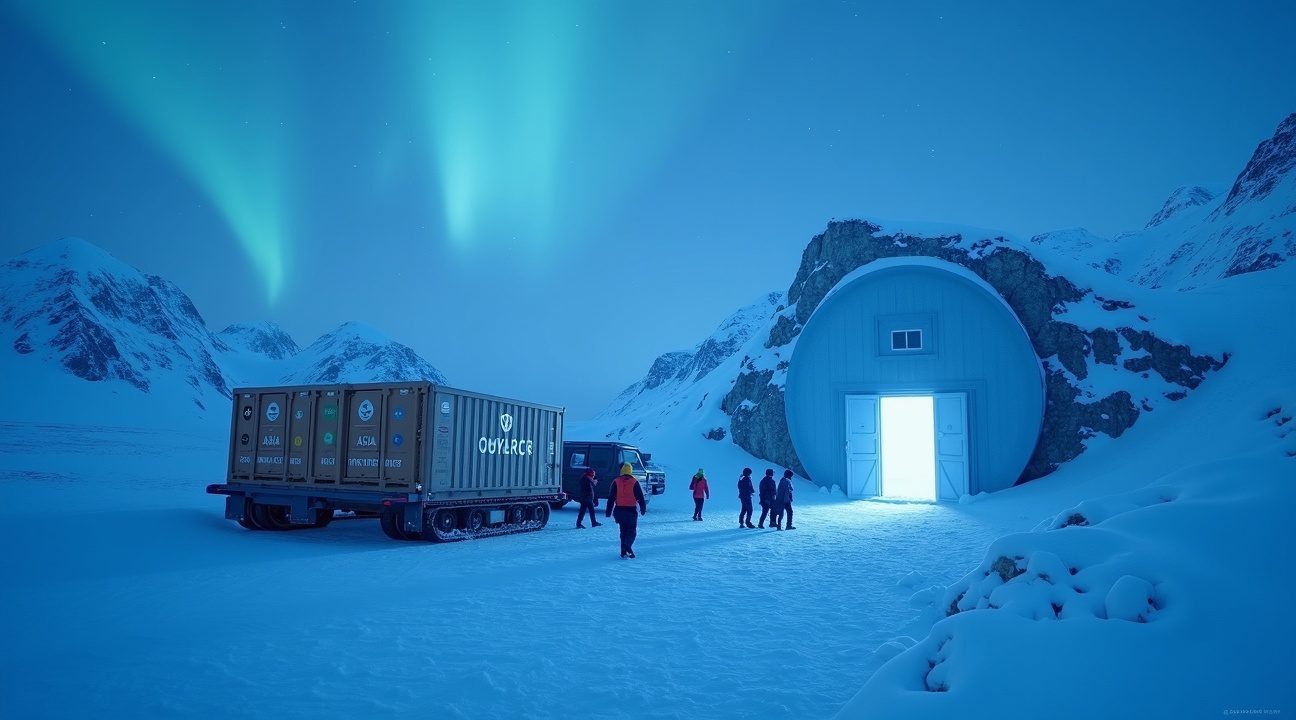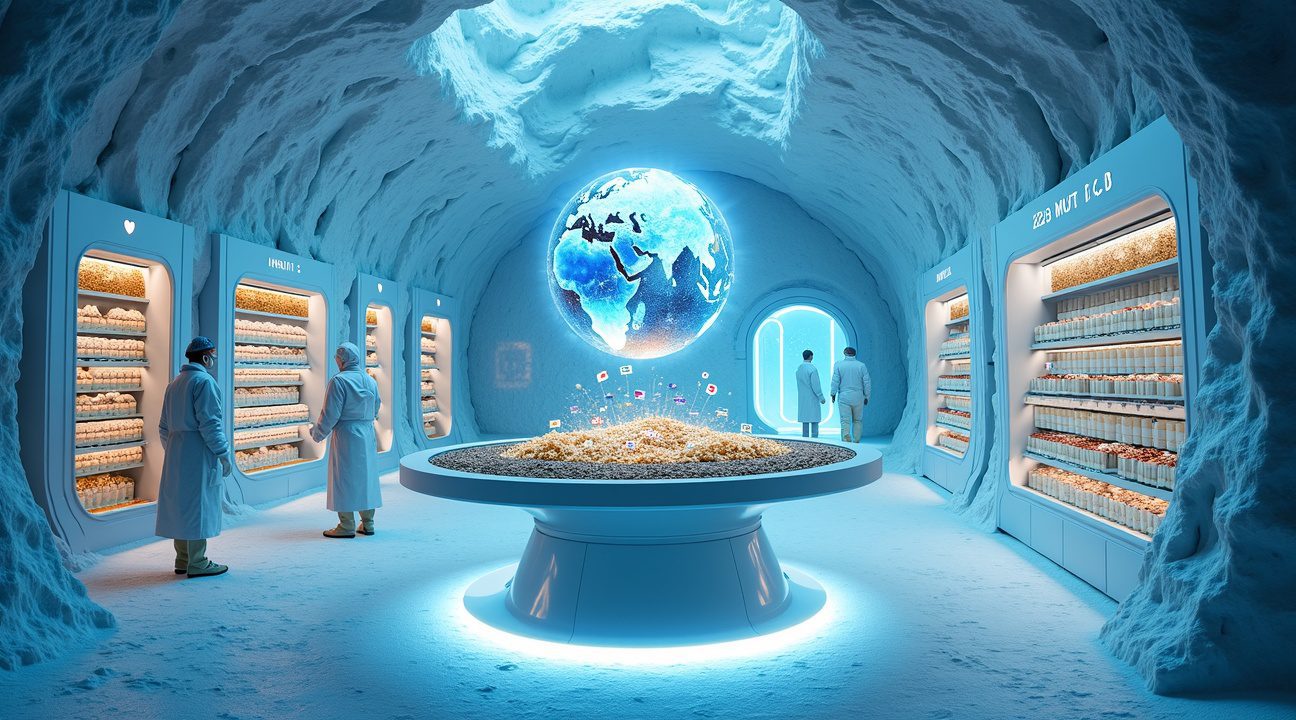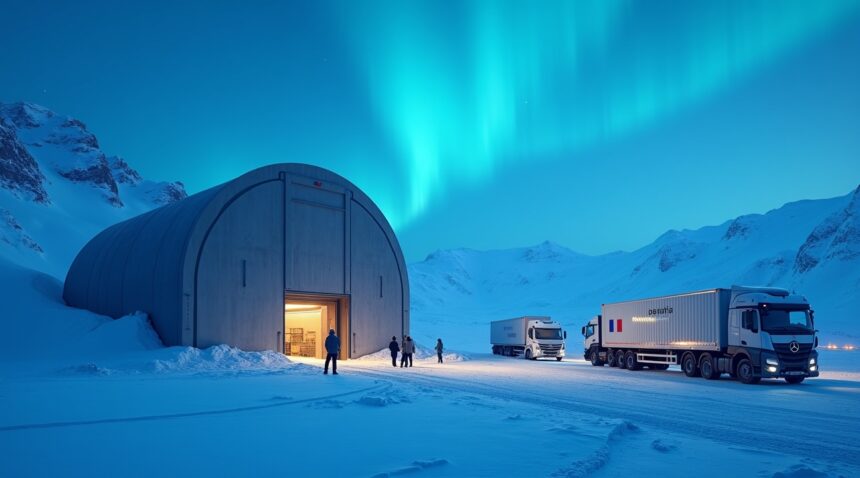The Svalbard Global Seed Vault operates on one of the world’s most restrictive access schedules, opening its doors just six times annually for carefully coordinated deposit events that bring together genebanks from across the globe.
This Arctic facility houses over 1.3 million seed samples from 223 countries and territories, serving as humanity’s ultimate insurance policy against agricultural catastrophe while maintaining strict protocols that ensure only authorized institutions can contribute to this critical genetic repository.
Key Takeaways
- The vault opens only six times per year for deposit events, with each opening requiring months of advance planning and coordination between international genebanks and Norwegian authorities.
- Currently safeguards approximately 1.3 million seed samples representing over 6,000 plant species from 223 countries, with storage capacity for up to 4.5 million samples.
- Built 100-145 meters deep into an Arctic mountain near Longyearbyen, Svalbard, where natural permafrost and engineered cooling systems maintain optimal preservation temperatures of -18°C.
- Depositing institutions retain full ownership of their seeds and are the only entities authorized to withdraw their materials, ensuring the vault functions as backup storage rather than a global commons.
- Recognized globally as one of Time’s Best Inventions of 2008 and named among the most influential projects of the last 50 years by the Project Management Institute.
Strategic Location and Natural Advantages
The Svalbard facility exemplifies how strategic location selection can create natural preservation advantages. Norwegian officials chose this Arctic site specifically for its stable permafrost conditions and remote location, which provides both security and ideal storage conditions. The vault’s position 130 meters above sea level protects it from potential sea-level rise, while the surrounding permafrost helps maintain sub-zero temperatures year-round.
Engineered Redundancy and Preservation
Engineering systems supplement the natural cold environment with mechanical refrigeration units that maintain internal temperatures at a constant -18°C. This dual-layer approach ensures seed viability even if mechanical systems experience temporary failure. The vault’s infrastructure also implements multiple layers of redundancy to guard against environmental threats and human tampering.
International Cooperation and Controlled Access
International cooperation is key to the vault’s operational success. Each of the six annual openings involves careful coordination between depositing genebanks and Norwegian administrative teams. This limited access protocol helps prevent contamination and ensures rigorous documentation for every seed sample that enters the facility.
Ownership Rights and Institutional Control
Ownership protocols ensure only the original depositing institutions can withdraw their samples. This model supports intellectual property rights and maintains the vault as a secure backup system, rather than a universally shared repository.
Future-Proof Design and Capacity Planning
The Svalbard Global Seed Vault was built with long-term scalability in mind, capable of storing up to 4.5 million seed samples. With current holdings representing less than one-third of maximum capacity, the vault is well-positioned to support continued global contributions over future decades.
Global Recognition and Impact
The vault’s innovative and collaborative approach to global food security and biodiversity preservation has earned it widespread recognition. It was highlighted in Time magazine’s Best Inventions of 2008 and recognized by the Project Management Institute as one of the most influential projects of the past 50 years. These honors underscore how thoughtful engineering and international cooperation can safeguard humanity’s agricultural future.
The World’s Most Exclusive Facility Opens Only Six Times a Year
The Svalbard Global Seed Vault operates on one of the most restrictive access schedules of any facility on Earth. I find it fascinating that this critical infrastructure opens its doors for just six deposit events annually, creating an exclusivity that surpasses many of the world’s most secure installations.
Each deposit event represents a carefully orchestrated operation that brings together genebanks from across the globe. These coordinated shipments arrive through a complex logistics network that ensures seeds maintain their viability during transport to the Arctic archipelago. The timing of these openings isn’t arbitrary – they align with seasonal considerations and the operational capacity of the facility’s specialized staff.
Strict Protocols Govern Every Access
The path to depositing seeds requires adherence to stringent depositor agreements that establish clear protocols for participation. Genebanks must demonstrate compliance with the International Treaty on Plant Genetic Resources before they can contribute to the vault’s collection. This treaty framework ensures that deposited materials serve the global good while respecting the rights of originating countries.
Depositor agreements establish several key principles that govern access:
- Seeds remain the exclusive property of the depositing institution
- Only the original depositor can request withdrawal of their materials
- Deposits must come from recognized genebanks with proper documentation
- All shipments require advance coordination with vault operators
- Contributors must maintain duplicate collections at their home institutions
The October 2024 deposit event exemplifies the scale these operations can achieve. More than 30,000 new seed samples from 21 countries were processed during this single opening, demonstrating the global reach and coordination required for each event. This particular deposit included varieties from institutions spanning multiple continents, from traditional crop varieties to wild plant relatives.
The limited opening schedule serves multiple purposes beyond security. It allows the facility’s small staff to focus on proper processing and storage of incoming materials without constant interruption. The vault’s location in Svalbard presents logistical challenges that make frequent access impractical, particularly during the harsh Arctic winter months when space exploration missions face similar environmental obstacles.
Each deposit event requires months of advance planning. Genebanks must coordinate their shipments to arrive within specific timeframes, ensuring that seeds don’t spend extended periods in transit where temperature fluctuations could compromise their viability. The vault’s operators work closely with international shipping companies that specialize in temperature-controlled cargo to maintain the cold chain from origin to final storage.
The ownership structure distinguishes this facility from other seed storage operations. While many assume the vault functions as a global commons, the reality is more nuanced. Depositors retain full ownership rights over their contributions, treating the facility as a backup storage location rather than a surrender of genetic resources. This arrangement has helped overcome political sensitivities that might otherwise prevent countries from participating.
Security measures extend beyond the physical barriers protecting the vault. The limited access schedule creates an additional layer of protection by minimizing human activity around the facility. Each opening requires coordination with Norwegian authorities who oversee Svalbard’s governance, adding governmental oversight to the scientific protocols.
The exclusivity of these deposit events reflects the vault’s role as a last resort rather than an active research facility. Unlike traditional genebanks where scientists regularly access materials for research and breeding programs, the Svalbard vault serves as insurance against catastrophic loss. This function aligns with broader concerns about global resilience, similar to how nations prepare for various challenges including geopolitical conflicts that could threaten food security.
The six-times-per-year schedule has proven sufficient to accommodate the global community’s needs while maintaining the facility’s security and operational integrity. This carefully managed approach ensures that future generations will have access to the genetic diversity necessary for food production, regardless of what challenges they may face.

Built 1,300 Kilometers Beyond the Arctic Circle for Maximum Security
Deep inside Platåberget, or ‘Plateau Mountain,’ the Global Seed Vault stands as humanity’s ultimate insurance policy against agricultural catastrophe. I’ve learned that Norwegian engineers chose this remote location near Longyearbyen on the Svalbard archipelago for compelling reasons – its isolation, natural permafrost, and exceptional geological stability create an ideal environment for long-term seed preservation.
The vault’s entrance leads visitors on a journey 100–145.9 meters (478.7 feet) into the mountain’s core. Three storage rooms stretch out like underground chambers, each measuring approximately 9.5–10 meters wide, 6 meters high, and 27 meters long. These dimensions weren’t chosen randomly – they provide optimal storage capacity while maintaining structural integrity within the mountain’s frozen bedrock.
Temperature Control Systems Ensure Perpetual Preservation
Climate control represents the vault’s most critical feature. Engineers maintain storage areas at a constant -18°C (-0.4°F), the optimal temperature for maximizing seed longevity. This controlled environment ensures seeds remain viable for decades or even centuries. Natural permafrost surrounding the facility maintains temperatures around -4°C, creating an additional safety net should mechanical cooling systems ever fail.
Norwegian Investment in Global Food Security
Norway invested approximately USD 9 million in construction costs when the facility opened in 2008. The Norwegian government didn’t just fund this project – they created a collaborative management structure involving the Ministry of Agriculture and Food, the Nordic Genetic Resource Centre (NordGen), and the Crop Trust. This partnership ensures professional oversight while maintaining the vault’s disaster-proof protocols.
The facility’s Arctic location offers natural advantages that complement human engineering:
- Permafrost acts as nature’s refrigerator.
- Remote setting protects against potential threats that might compromise more accessible storage facilities.
Even during global conflicts like the current geopolitical tensions, this isolated vault remains secure from human interference.
Access restrictions maintain the vault’s integrity – doors open only up to six times annually for seed deposits or maintenance. This limited access schedule protects stored genetic material while allowing essential operations to continue. The vault’s designers understood that rare access enhances security, preventing contamination and unauthorized entry that could compromise millions of preserved seed varieties.
Similar to how space exploration pushes technological boundaries, this underground facility represents humanity’s forward-thinking approach to preserving Earth’s biodiversity for future generations.
Housing 1.3 Million Seed Samples from 223 Countries and Territories
The vault currently safeguards approximately 1,331,458 seed samples that represent over 6,297 distinct plant species, containing hundreds of millions of individual seeds from across the globe. This collection spans contributions from 223 countries and territories, making it the most comprehensive agricultural backup system ever assembled. India stands as the largest contributor to this global effort, providing an impressive 95 million seeds to the facility’s collection.
Comprehensive Agricultural Diversity
The storage capacity demonstrates remarkable foresight, designed to accommodate up to 4.5 million seed samples, which translates to approximately 2.25–2.5 billion individual seeds. Each sample typically contains about 500 seeds, ensuring sufficient genetic material for future restoration efforts. This systematic approach mirrors the precision found in other ambitious scientific endeavors, much like how space exploration requires careful planning for humanity’s future.
The composition of stored materials reveals humanity’s agricultural priorities and diversity:
- Grains dominate the collection at 69%, with rice alone accounting for 85 million seeds
- Legumes comprise 9% of the total samples
- Fruits, vegetables, herbs, and even some hallucinogenic plants like cannabis and opium make up the remainder
Major food crops receive priority treatment, including maize, rice, wheat, cowpea, sorghum, potato, barley, and lettuce from every global region. This comprehensive approach ensures that future generations will have access to the genetic foundation necessary for food security, regardless of climate changes or other global challenges that might affect agricultural systems.
The facility maintains strict exclusion policies regarding genetically modified organisms (GMOs), focusing instead on preserving naturally occurring genetic diversity. This decision reflects the vault’s commitment to maintaining authentic genetic heritage rather than engineered variants. The exclusion policy ensures that stored samples represent true genetic diversity that evolved naturally over thousands of years.
Each contribution from the 223 participating countries and territories adds unique genetic characteristics that could prove crucial for future food security. The global nature of this collection means that crops adapted to specific climates, soil conditions, and environmental challenges are preserved for potential future use. This international cooperation demonstrates how scientific initiatives can transcend political boundaries, similar to collaborative efforts seen in advanced transportation research that benefits all humanity.

The Ultimate Insurance Policy Against Global Food System Collapse
The Svalbard Global Seed Vault functions as humanity’s ultimate safety net against agricultural catastrophe. I consider this facility the world’s most comprehensive backup system for crop genetic diversity, housing over one million seed samples from every corner of the globe. This underground repository serves as a failsafe when national genebanks face destruction from conflicts, natural disasters, or simple equipment failures.
How the Global Backup System Works
The vault operates on a straightforward principle: any recognized genebank worldwide can deposit seeds, provided they meet specific depositor agreements and comply with international treaties. These requirements ensure quality control while maintaining the facility’s role as a neutral, secure storage location. The system supports global food resilience by creating multiple copies of essential crop varieties that might otherwise disappear forever.
When disasters strike, genebanks can retrieve their deposited seeds to rebuild their collections. This disaster recovery mechanism has already proven invaluable. I’ve seen how climate change, political instability, and equipment failures regularly threaten seed collections worldwide. The vault’s presence means that even if entire national collections vanish, the genetic material remains safe in Svalbard’s remote location.
The facility’s design reflects its critical mission. Built into a mountainside and maintained at minus 18 degrees Celsius, the vault can preserve seeds for decades or even centuries. This preservation capability extends far beyond what most individual genebanks can achieve, making it an irreplaceable resource for future generations.
The vault addresses a fundamental vulnerability in our food system: the gradual loss of crop diversity. Modern agriculture relies heavily on a limited number of high-yielding varieties, creating dangerous dependencies. When these crops fail due to disease or changing climate conditions, farmers need access to different genetic varieties that can adapt to new challenges.
I recognize that this seed vault represents more than just storage—it embodies international cooperation on food security. Countries that might disagree on other issues unite in protecting agricultural diversity. This collaboration becomes increasingly important as global conflicts and climate change threaten food production systems worldwide.
The vault’s limited access schedule reflects its role as a true backup facility rather than a working laboratory. Those six annual openings allow for deposits and withdrawals while maintaining the facility’s security and preservation conditions. This careful management ensures that the seeds remain viable for when they’re truly needed, serving as the ultimate insurance policy against global food system collapse.
Global Recognition as One of Time’s Best Inventions
The Svalbard Global Seed Vault earned its place among Time’s Best Inventions of 2008, ranking an impressive No. 6 on this prestigious list. This recognition came just one year after its opening, highlighting the immediate global understanding of its critical importance to humanity’s future. Time’s acknowledgment brought widespread attention to this Arctic facility, cementing its reputation as humanity’s agricultural insurance policy.
International acclaim continued when the vault received the Norwegian Lighting Prize in 2009, recognizing not only its functional brilliance but also its architectural achievement in the harsh Arctic environment. The Project Management Institute later elevated the vault’s status further, naming it one of the most influential projects of the last 50 years. This designation speaks to the vault’s unprecedented scope and its role in preserving global food security for future generations.
Recognition Beyond Scientific Circles
These accolades transformed the facility from a specialized scientific repository into a globally recognized symbol of hope and preparedness. The vault’s designation as the ultimate backup for agriculture resonates with scientists, policymakers, and the general public alike. Each award reinforces the facility’s position as the world’s most comprehensive crop repository, safeguarding genetic diversity that could prove essential during global crises.
The strategic importance of this facility extends beyond mere storage – it represents humanity’s commitment to preserving agricultural heritage for future generations. While researchers continue to study space exploration as humanity’s next frontier, the vault ensures our earthly foundations remain secure. International recognition validates the foresight of its creators and supporters who understood that protecting crop diversity requires the same urgency as addressing other global challenges, much like how nations respond to current geopolitical situations.
The vault’s reputation as the “doomsday vault” stems from its role as humanity’s agricultural safety net. This nickname, while dramatic, accurately captures the facility’s function as the final backup when all other seed banks fail. The recognition it has received confirms that preserving genetic diversity isn’t just about scientific achievement – it’s about ensuring human survival in an uncertain future.
Engineering Marvel Combining Technology with Natural Preservation
I find the Svalbard Global Seed Vault’s preservation system fascinating because it expertly combines human innovation with natural Arctic conditions to create an unparalleled storage environment. The facility’s designers understood that long-term seed preservation requires multiple layers of protection, which is why they engineered a system that relies on both advanced technology and the natural benefits of its Arctic location.
Advanced Storage Technologies
The seed preservation process begins with sophisticated packaging systems that protect genetic material from environmental threats. Seeds arrive at the facility sealed in airtight aluminum bags, which are then placed within three-ply foil packaging for maximum protection against moisture, oxygen, and temperature fluctuations. This dual-barrier approach ensures that even if one layer fails, the seeds remain protected for decades or potentially centuries.
Engineering systems maintain precise -18°C temperatures throughout the storage chambers, creating optimal conditions for seed longevity. The facility’s refrigeration units work continuously to preserve this critical temperature, while backup systems stand ready to take over if primary cooling fails. These mechanical systems represent the technological backbone of the preservation effort, much like how space exploration requires backup systems for mission-critical operations.
The vault’s construction integrates seamlessly with Svalbard’s natural advantages. Mountain insulation provides an additional layer of temperature stability, while permafrost acts as nature’s own refrigeration system. Even if all mechanical cooling systems failed simultaneously, the natural Arctic conditions would continue protecting the seeds at temperatures well below freezing.
Storage rooms within the facility were designed specifically for maximum seed longevity, featuring reinforced concrete walls and specialized ventilation systems. The chambers maintain consistent humidity levels while preventing condensation that could damage stored genetic material. Each room operates as an independent preservation unit, ensuring that problems in one area won’t compromise the entire collection.
Construction materials and techniques were selected to withstand natural disasters and potential conflicts for centuries. The facility’s entrance tunnel extends deep into the mountainside, protecting stored seeds from surface-level threats while maintaining easy access for authorized personnel. Blast-resistant doors and reinforced walls provide security against both natural and human-made catastrophes.
The engineering team recognized that combining mechanical precision with natural Arctic stability creates redundancy that purely technological solutions cannot match. While global conflicts continue to affect seed banks in other regions, similar to how international tensions impact scientific facilities, Svalbard’s isolated location and natural protection offer unmatched security.
Climate control systems work in harmony with the mountain’s thermal mass, reducing energy consumption while maintaining stable conditions. The facility’s design takes advantage of natural temperature stability found deep within the mountain, where seasonal variations have minimal impact on internal conditions.
Monitoring systems throughout the vault track temperature, humidity, and structural integrity around the clock. Sensors alert facility managers to any changes that could threaten seed viability, while automated systems can respond to problems faster than human operators. This constant vigilance ensures that both technological and natural preservation elements function optimally.
The combination of cutting-edge preservation technology with natural Arctic conditions represents a unique approach to long-term storage that I believe sets the standard for future preservation facilities. By respecting and utilizing the natural advantages of its location rather than fighting against them, the vault achieves preservation capabilities that purely artificial environments struggle to match.
This engineering approach demonstrates how human innovation can amplify natural advantages rather than replace them entirely. The result is a preservation system that’s both more reliable and more sustainable than facilities that depend solely on mechanical systems, creating a true marvel of conservation engineering.
Sources:
Crop Trust – “Our Work: Svalbard Global Seed Vault”
Alfa Laval – “Svalbard Global Seed Vault”
Wikipedia – “Svalbard Global Seed Vault”
Oceanwide Expeditions – “Inside the Svalbard Global Seed Vault”
Svalbardi – “What Seeds Are in the Svalbard Global Seed Vault”
Crop Trust – “Our Work: Svalbard Global Seed Vault FAQs”
Norwegian Government (regjeringen.no) – “Svalbard Global Seed Vault”


